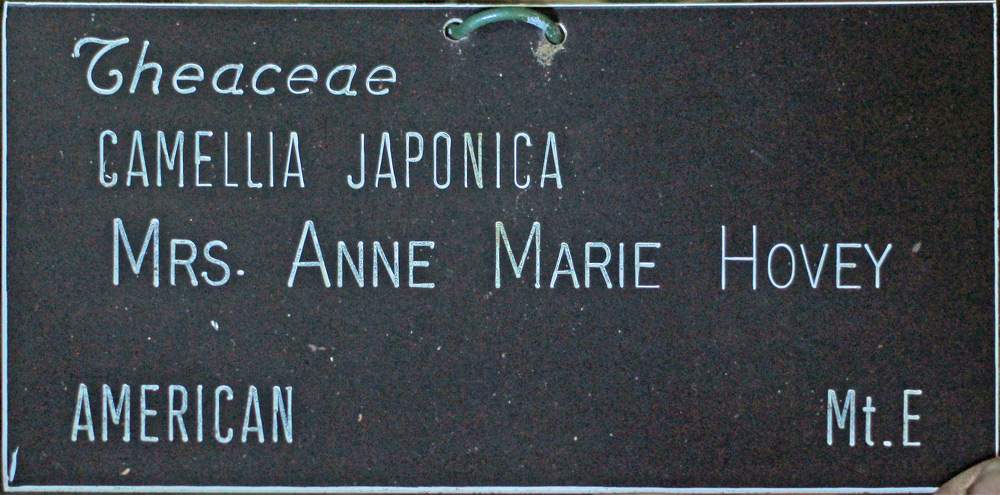The weather forecast for yesterday was terrible but it was the only day this week that I was going to be able to get up to Mt. Edgcumbe so I sketched it in as a day for engraving labels. On the day, the weather had a change of heart but I spent the morning doing labels anyway.
It’s something of a cliché, but the more you get to know about Camellias, the more you realise you don’t know. I know that several plants in the collection are labelled incorrectly. They are pink when they should be striped, or there are two completely different varieties sporting the same name on the label; that sort of thing.
A large bush in one of the earliest planted sections, so planted in the early 1980’s, had two labels, one saying Camellia japonica ‘Mrs Anne Marie Hovey’, the other Camellia japonica ‘A M Hovey’. Elsewhere in the collection is another bush, very different in appearance, also labelled ‘Mrs Ann Marie Hovey’. In the collection records the former version was down as ‘C. M. Hovey’. ‘Mrs Anne Marie Hovey’ is noted for producing flowers in several different colours which neither of these does, so that name seemed unlikely. ‘C. M. Hovey’ seemed more credible, notwithstanding it is described as “bright crimson scarlet” and both of my specimens were at best deep pink.
‘Julia Drayton’ has a sport called ‘Flowerwood’, the same as its parent but with fimbriated petals. There were two ‘Flowerwood’s in the collection, neither showing much fimbriation but just enough sometimes to make me think they were right. They also closely matched two plants labelled ‘Purple Emperor’, a synonym for ‘Julia Drayton’. A plant actually labelled ‘Julia Drayton’ turned out to be ‘Grand Sultan’. Nevertheless, I effectively had four plants of ‘Julia Drayton’ that I was satisfied were the right thing. It turns out that one of the supposed ‘Mrs Anne Marie Hovey’ plants is identical to them, plus another plant that was propagated from it.
I started with one ‘Julia Drayton’ which turned out to be ‘Grand Sultan’ and now have six ‘Julia Drayton’s. I’m not sure that there aren’t more to come, in that two plants labelled ‘Dona Jane Andreson’ look virtually identical as well.
I don’t take the decision to relabel something lightly. I compare the flowers for colour, form and flowering time. I compare the foliage minutely: colour, glossiness, shape, size, pubescence, timing and colouration of new growth. I compare size, shape, pubescence of flower and vegetative buds.
What was labelled ‘Mrs Anne Marie Hovey’ has now been relabelled ‘Julia Drayton’ and I have a high level of confidence that it is now right. Even so, I acknowledge the possibility that I might not be right and am open to being persuaded of the fact. In the meantime I am feeling quite pleased with myself.


Once I’d escaped the confines of the “office” and went out into the park I was expecting to find most of the Camellia blooms to have been damaged or destroyed by frost, but Mt Edgcumbe is very favoured climatically and most had escaped damage. Especially pleasing was finding the single bud that had been produced by a bush of Camellia sasanqua ‘Early Pearly’ that I’d planted in January 2020 had opened and was undamaged.

Then, since it is a fact widely acknowledged that all good things must come in threes, I shall sing the praises of Camellia sasanqua ‘Paradise Venessa’. On the same day at the end of January 2020 I also planted a fair sized bush of ‘Paradise Venessa’. There was already a plant of it in the species section, located under trees and well back from any open space. It flowers regularly enough but not very freely and the habit of the plant is very open and wide spreading. I planted the new one in an open situation with plenty of direct sunlight in order to have plants in two contrasting situations to compare. It has settled in well and this year has a good number of flowers on it. They are large, they are lovely and for at least the duration of that visit to the park, they were my favourite.





